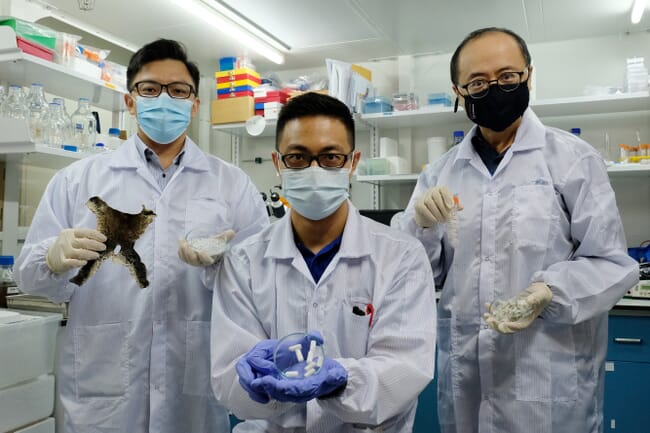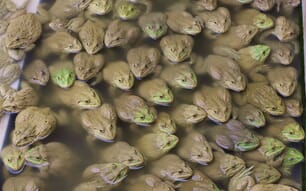
© NTU
Scientists at Nanyang Technological University (NTU) have developed a new biomaterial, made entirely from discarded bullfrog skin and fish scales, that could help in bone repair. The porous biomaterial, which contains the same compounds that are predominant in bones, acts as a scaffold for bone-forming cells to adhere to and multiply, leading to the formation of new bone.
The fishery waste was collected from Khai Seng Fish Farm and Jurong Frog Farm. To make the biomaterial, the team first extracted Type 1 tropocollagen (many molecules of which form collagen fibres) from the discarded skins of the American bullfrog, locally farmed and imported into Singapore in large numbers for consumption; and hydroxyapatite (a calcium-phosphate compound) from the scales of snakehead fish, commonly known as the Toman fish.
Ms Chelsea Wan, director of Jurong Frog Farm, said: “The aquaculture industry is an important avenue to meet the global growing demand for safe and quality seafood, but a big challenge we face is the huge wastage and downcycling of valuable aquatic resources. In Singapore, the combined annual consumption of frog flesh and fish is estimated to be around 100 million kilograms, making bullfrog skin and fish scales two of the largest aquaculture waste side streams here. The integration of multiple seafood waste streams into a single high value product is a leading example of sustainable innovation for the aquaculture industry.”
Through laboratory experiments, the NTU Singapore team found that human boneforming cells seeded onto the biomaterial scaffold successfully attached themselves and started multiplying – a sign of growth. They also found that the risk of the biomaterial triggering an inflammatory response is low. Such a scaffold could be used to help with the regeneration of bone tissue lost to disease or injury, such as jaw defects from trauma or cancer surgery. It could also assist bone growth around surgical implants such as dental implants.
The scientists believe the biomaterial is a promising alternative to the current standard practice of using a patient’s own tissues, which requires additional surgery for bone extraction. At the same time, the production of this biomaterial tackles the problem of aquaculture waste, said assistant professor Dalton Tay of the NTU School of Materials Science and Engineering (MSE), who led the multidisciplinary study.
Prof Tay said: “We took the ‘waste-to-resource’ approach in our study and turned discards into a high-value material with biomedical applications, closing the waste loop in the process. Our lab studies showed that the biomaterial we have engineered could be a promising option that helps with bone repair. The potential for this biomaterial is very broad, ranging from repairing bone defects due to injury or ageing, to dental applications for aesthetics. Our research builds on NTU’s body of work in the area of sustainability and is in line with Singapore’s circular economy approach towards a zero-waste nation.”
Clinical associate professor Goh Bee Tin, director for research at the National Dental Centre Singapore, who was not involved in the study, said: “The National Dental Centre Singapore is excited about the use of bullfrog skin as a natural biomaterial for tissue regeneration. We see many potential dental applications ranging from the regeneration of gum tissues in periodontal disease, to bone for placement of dental implants, to jawbone following tumour surgery. Obviating the need for additional bone harvesting surgery also translates to time and cost savings, and less pain for patients.”
The research team has filed patents for the biomaterial's wound healing and bone tissue engineering applications. The team is now further evaluating the long-term safety and efficacy of the biomaterial as dental products under a grant from the ChinaSingapore International Joint Research Institute and aims to bring the waste-to-resource technological pipeline closer to commercialisation
Looking ahead, the research team hopes to work with clinical and industrial partners on animal studies to find out how tissues in the body would respond to this biomaterial in the long term, and the material’s ability to repair bone defects and dermal wounds, as well as to bring the entire waste-to-resource technological pipeline closer to commercialisation.




